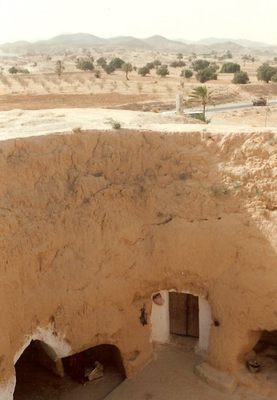About
The Amazigh underground homes of Matmata lie in an arid, pockmarked landscape in the parched valleys of southern Tunisia's Djebel Dahar region. Made famous by Star Wars, these traditional structures are now threatened as residents move away to live in towns and villages.
Every Star Wars fan worth their salt knows a little about the location of Luke Skywalker’s house: not Tatooine, but the actual filming location in Tunisia. Or, to be more precise, the Hotel Sidi Driss in Matmata, chosen as the set for Luke’s family home thanks to its otherworldly underground construction.
But the Hotel Sidi Driss isn’t the only underground building of its type. Similar structures dot the landscape around Matmata, a pitted land of palm trees and olive groves. It’s an open question as to when nomadic tribes decided to settle here in their underground houses, and the entire area was largely unknown to the outside world until the 1960s, when severe flooding brought it to the attention of the Tunisian government.
The houses themselves are built by first digging a deep circular pit into the sandstone, which is soft enough to work with simple hand tools. Caves are then dug out around the edges of the pit, forming the underground rooms and leaving the main pit as a courtyard.
Once finished, the troglodyte construction offers a fine escape from the heat of the day, and a sturdy home that could survive for many years. Unless, of course, heavy rains like those of the 1960s lead to flooding, damage and in some cases the destruction of the underground dwellings. Periods of extreme drought can also damage the homes.
Since the last major flooding, and despite the tourism generated by Star Wars, another threat to the homes has arisen: rural depopulation. Locals had already begun moving out of their traditional homes during the 1960s and 1970s, when President Habib Bourguiba was trying to modernize the country and many Amazigh moved to the towns.
More have since left, slowly trickling away with the decline of tourism. Tunisia’s tourism industry has been struggling ever since the country’s 2011 Arab Spring uprising, and was further damaged following the 2015 attacks in Tunis and Sousse, which directly targeted tourists.
Some locals have remained, however, living with their families in their underground households, working their olive farms and occasionally accepting tips from tourists who want a tour of their home. And today, only a handful of men still know how to dig and maintain these special Amazigh dwellings.
Related Tags
Know Before You Go
There is no one location only for these underground houses. Many are visible from the main road, while others require some off-roading. The whole province of Matmata is littered with them. Some are abandoned; some have been converted to souvenir stores and/or cafes; and some are still inhabited.
Tunisia: The Sahara, Mosaics & Star Wars Relics
A Sahara journey through ancient oases, diverse culture, & delicious cuisine.
Book NowCommunity Contributors
Added By
Published
July 16, 2018


































































